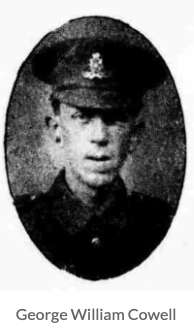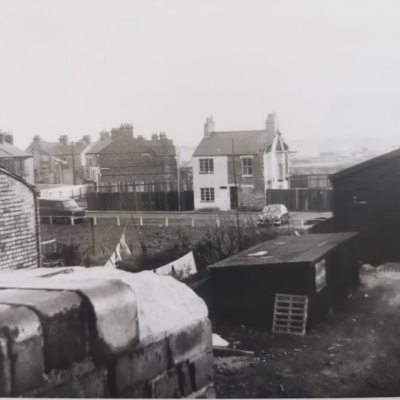Search by topic
- archaeology
- Building of Local Interest
- charity
- church
- crime
- dressmaker
- fire
- Great Eastern Railway
- Listed building
- Mapping Relief
- medieval
- oral history
- poverty
- Public House
- Rattee & Kett
- Religious House
- Roman
- scholar
- school
- Then and Now
- tudor
- women
- work
- world war one
- world war two
Search by text
79 Argyle Street
History of 79 Argyle Street
79 Argyle Street had been the home to members of the Hudson family for 80 years.
1901 Census
Robert Gould, born 1832 in Gazeley, Suffolk – General Labourer – Head
Susannah Gould, born 1827 in Cockfield, Suffolk – Wife
1911 Census
Thomas W. Reynolds, born 1877 in Cambridge, Motor Bus Conductor – Head
Annie Reynolds, born 1878 in Isleham – Wife
Frank Reynolds, born 1898 in Isleham – Son
Arthur Reynolds, born 1902 in Cambridge – Son
Nellie Reynolds, born 1905 in Cambridge – Daughter
Doris Reynolds, born 1910 in Cambridge – Daughter
Horace Reynolds, born 1911 in Cambridge -Son
Robert Cornell, born 1888 in Cambridge – Boarder – Fish Monger** (see below)
Norman Webber, born 1848 in Isleham – Widower – Visitor – (father-in-law to Head)
Robert Arthur Cornell: Private 14728, 8th Battalion, Suffolk Regiment. Killed in action 18 January 1916, aged 28 and is buried in Albert Communal Cemetery Extension, Franc.. Born and enlisted in Cambridge. Son of Mrs. Mary Fanny Cornell, of New Chesterton, Cambridge.
In 1911 he was a boarder, aged 23, fishmonger, born Cambridge and residing at 79 Argyle Street, Cambridge. His parents were, by 1911, residents of the Victoria Friendly Societies Asylum in Victoria Road Cambridge. He lodged in Argyle Street probably because his uncle (Frederick) and family resided at No. 96. In 1901 he was living with his parents in Bradmore Street.
January, 1918
David and Mabel Hudson moved into 79 Argyle Street
David Hudson had come to Cambridge to work for the Great Eastern Railway. His brother, William, had already done likewise. See 120 Argyle Street.
1921 Census
David Hudson, born 1895 in Bluntisham, Locomotive Act. Driver, GER – Head
Mabel Ellen Hudson, born 1896 in Chesterton, Household duties – Wife
Leslie David Hudson, born 1918 in Cambridge – Son
By October, 1921
David Hudson
Mabel Ellen Hudson
Leslie David Hudson
Irene Joyce Hudson – Daughter
By March, 1923
David Hudson
Mabel Ellen Hudson
Leslie David Hudson
Irene Joyce Hudson
Sheila Ellen Hudson – Daughter
By January, 1931
David Hudson
Mabel Ellen Hudson
Leslie David Hudson
Irene Joyce Hudson
Sheila Ellen Hudson
Betty Margaret Hudson – Daughter
The family left 79 Argyle Street in the spring of 1939 to move to Perne Road.
1939 National Register
Archibald N. Stearn, born 1910 – Shop assistant grocery – Head
Blanche E. Stearn, born 1912 – Unpaid domestic duties – Wife
It is thought that Arthur P.D. Hudson and Greta Hudson (who married in 1939) lodged with Mr. and Mrs. Stearn at 79 Argyle Street
1942 Birth Record
Jennifer Hudson born to Arthur and Greta
1945 Electoral Roll
Blanche E. Stearn
Greta Hudson (and Jennifer)
1946 Electoral Roll
Greta Hudson (and Jennifer)
1947 Electoral Roll
Greta Hudson (and Jennifer)
1948 Electoral Roll
Arthur P.D. Hudson – Arthur had been in the Army from 1945 to 1947 and previously in the Home Guard
Greta Hudson
1952 Birth Register
Sandra Hudson born to Arthur and Greta
Property was sold in 1957 by Mary Elizabeth Scholastica Lunniss to Arthur Philip David Hudson (nephew of David Hudson, above)
Mr and Mrs. Lunniss owned at least 79, 81 and 83 Argyle Street according to Title Registers.
1957 – 1978
Arthur and Greta Hudson continued to live at 79 Argyle Street as owner occupiers.
1978 Death Register
Arthur Hudson died
1978-1998
Greta Hudson continued to live at 79 Argyle Street
1998 Electoral Roll
Property empty
1998
Sold to Mr. William Lyndon
2000 Electoral Roll
5 people of different surnames – presumably student accommodation?
2017
Sold to Mr. Alexander Donald Charles Chadwick
In 2003 Mrs B Edwards sent her reminiscences of Romsey Town to the Museum.
I was born in Argyle Street in 1931 so my earliest memories are of Romsey Town. We lived in a terraced house with just a cold tap in the kitchen and an outside toilet. Mother boiled her white laundry in a brick built copper in the kitchen. The water was also heated once a week for baths in a tin bath. We had a sitting room with a coal-fired range and a front parlour.
It the wind was blowing from the wrong direction the ‘white’ washing couldn’t be hung on the washing line because of black smuts flying about from the steam engines nearby.
I can remember all the shops along Mill Road and I can even remember the brick wall from Sedgwick Street to Cavendish Road, behind which was “The Lodge”, home I think of the Smith family. This stretch of road is now the Broadway; in fact when the new shops were built a wool shop on the corner of Cavendish Road was named ‘The Lodge Wool Shop.”
St Phillips Church is on the corner of Thoday Street and then came four bay windowed houses, but these have now been incorporated into the Co-op supermarket.After Catharine Street came Whiteheads green grocery shop, then Kitt’s sweet shop, where I have stood for hours deciding how to spend a half-penny. Then came Mr Foster’s shoe repair shop.
On the opposite side of the road o the corner of Campbell St was Livermores hardware shop, Mrs Harvey’s wool shop and then Mr Hammond’s sweet shop. Next to Mill Road Baptist Church was Sennitt’s butchers, Doreen’s dress shop, Jellings greengrocery, Hunt the jewellers, Webb’s radio, Norman’s drapers. Just after Cockburn Street was parker’s butchers and North’s bakers. Mr Palmer the chemist was at 206 Mill Road. If anything was ailing us Mr Palmer always put us right.
Rather along the road was Warboy’s grocery shop, Miss Amey’s hat shop and ladies underwear (not lingerie in those days.) I can still see the combinations and corsets exhibited in the window. Mrs Butler’s dress shop was next door and I well remember the Rayner family keeping the Post Office for many years.
I started my school days at St Phillips Infant School. Miss Jackson was the head mistress. She taught the girls to knit and our first job was to make squares of cotton yarn to make dusters to clean our slates. We had to make two – one for ourselves and one for a boy!! After that we went onto something difficult!! We made what turned out to be an envelope, thus showing us how to decrease to make a point. We made a knitted strap and these were to keep a clean hankie in!!
When I was seven I ent onto the Romsey School. Soon after war was threatened and the school was used as a distribution centre for gas-masks.
When war started, the air raid shelters were still to be built and we were told to get under our desks if bombs were falling. Eventually shelters were built at the back of Romsey House.
We had a battery / accumulator radio. I often had the job of taking the accumulator to Mr Webbs radio shop to have it charged up and I was warned to keep it away from my clothes because the acid would burn. Never mind about my skin!!
Backing onto our back garden from Hope Street was Mr and Mrs Curtis’s cow sheds – they having a dairy herd. During the summer months, when they had grazing rights, one of their sons would take the herd across Mill Road into Catharine Street and onto Coldham’s Common and bring them back in the evening – he riding his bicycle behind them. I’d like to see it happen today.
I started work in 1945 but by this time we had moved to Perne Road. However I cycled into town everyday, still going into Romsey Town. Oh, the joy of cycling over Mill Road bridge just as an engine went under and getting covered in smoke.
I’ve lived in Landbeach nearly fifty years now but I shall always treasure my memories of Romsey Town. It was truly a ‘working class’ district – my kind of people.
Contribute
Do you have any information about the people or places in this article? If so, then please let us know using the Contact page or by emailing capturingcambridge@
License
This work is licensed under CC BY-NC-SA 4.0








